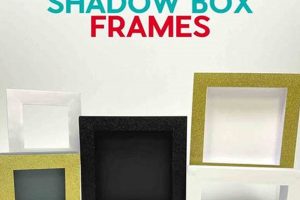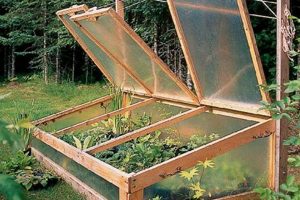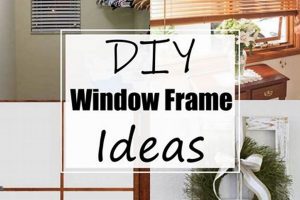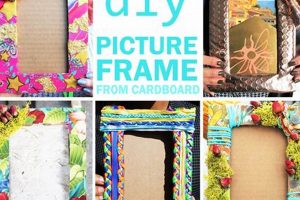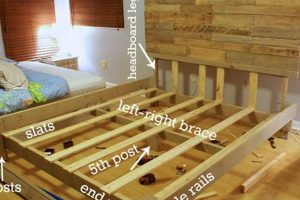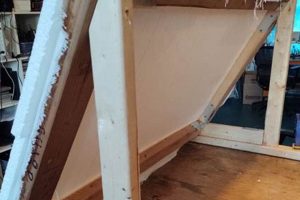The construction of a protective border and encompassing structure for artwork or photographs through individual effort is a process that allows for customization and cost savings. For instance, one might cut a piece of acid-free board to create a border for a print and then build a wooden enclosure to hold and display it.
This approach to presentation offers several advantages. It allows for complete control over the aesthetic, ensuring that the surrounding elements complement the artwork. Furthermore, it often represents a more economical solution compared to professional services. Historically, crafting these elements has been a traditional skill, passed down through generations, and often seen as an integral part of artistic expression.
The following sections will delve into the specific techniques, materials, and design considerations involved in creating customized presentation solutions. Further exploration of material selection, cutting techniques, and assembly methods will be provided.
Essential Considerations for Customized Art Presentation
The following recommendations address crucial aspects of crafting individual borders and enclosures for displayed artwork, ensuring both aesthetic appeal and long-term preservation.
Tip 1: Prioritize Acid-Free Materials: When selecting materials for both the border and the backing, ensure they are acid-free. Acidic components can damage artwork over time, leading to discoloration and deterioration.
Tip 2: Precise Measurement is Crucial: Accurate measurements are paramount. Measure the artwork meticulously before cutting any materials. Inaccurate dimensions can result in gaps or require recutting, wasting resources.
Tip 3: Employ Appropriate Cutting Tools: Utilize specialized cutting tools designed for board and framing materials. A mat cutter, for example, provides clean, beveled edges for the border. A miter saw ensures precise angles for frame construction.
Tip 4: Consider the Artwork’s Style: The chosen style and color of the border and enclosure should complement the artwork itself. A minimalist piece may benefit from a simple, unadorned border, while a more elaborate work may accommodate a more ornate enclosure.
Tip 5: Ensure Proper Sealing and Closure: When constructing the enclosure, ensure a tight seal to protect the artwork from dust and environmental factors. Secure backing boards with acid-free tape or specialized framing hardware.
Tip 6: Account for Expansion and Contraction: When working with wood, consider its natural expansion and contraction due to humidity and temperature changes. Allow for slight tolerances to prevent warping or cracking.
Tip 7: Utilize Glazing Wisely: When incorporating glazing, opt for UV-protective acrylic or glass to shield the artwork from harmful ultraviolet rays. Ensure the glazing is properly cleaned and free of imperfections before installation.
Adhering to these guidelines will contribute significantly to the creation of visually appealing and protective presentations for displayed artwork. Proper material selection and precise execution are essential for long-term preservation.
The following sections will explore advanced techniques and offer additional resources for individuals seeking to further refine their skills in personalized presentation solutions.
1. Material Selection
Material selection directly influences the longevity, aesthetic appeal, and protective capabilities of a self-constructed border and enclosure. The choice of materials is not merely an aesthetic decision; it is a fundamental determinant of the artwork’s long-term preservation. For instance, using acidic cardboard for a border will, over time, leach acids into the artwork, causing discoloration and embrittlement. Conversely, employing acid-free board ensures the artwork’s integrity for decades.
The practical significance of understanding material properties extends beyond preservation. Wood selection for the enclosure, for example, affects its stability and resistance to warping. Softwoods like pine are more susceptible to damage than hardwoods like oak or maple. Furthermore, the choice of glazing whether glass or acrylic determines the level of UV protection offered. Standard glass provides minimal UV filtration, while specialized acrylic sheets can block a significant portion of harmful rays. The use of appropriate adhesives and backing materials is equally crucial, preventing the introduction of damaging substances or creating unwanted pressure points on the artwork.
In summary, material selection constitutes a critical component in the successful creation of a customized border and enclosure. Neglecting this aspect can lead to irreversible damage and diminished aesthetic value. Careful consideration of material properties, compatibility, and long-term effects is essential for ensuring the artwork’s lasting protection and visual presentation. The cost-effectiveness of the overall project will be lost if the artwork or photograph is damaged by unsuitable materials.
2. Precise Cutting
Precise cutting is a fundamental requirement for successful individual creation of borders and enclosures for artwork. Accurate dimensions and clean edges are essential for both aesthetic appeal and the proper fitting of artwork within its presentation.
- Dimensional Accuracy
Dimensional accuracy ensures that the border and enclosure fit the artwork precisely. Inaccurate measurements result in gaps or overlaps, detracting from the visual presentation and potentially damaging the artwork. For example, if the border is too small, the artwork may be forced into the space, causing creases or tears. Conversely, if the border is too large, the artwork may shift within the enclosure, leading to abrasion and dust accumulation.
- Clean Edge Quality
Clean, smooth edges are crucial for a professional appearance. Ragged or uneven edges detract from the overall presentation. Tools such as a mat cutter with a sharp blade are necessary to achieve clean, beveled edges on the border. Similarly, a miter saw with a fine-tooth blade is essential for producing accurate and smooth cuts on enclosure components.
- Mitre Joint Precision
For enclosures constructed with angled corners, precise mitre joints are essential for creating a seamless and visually appealing structure. Gaps in mitre joints are readily apparent and compromise the overall quality. Specialized tools like a miter saw with digital angle measurement enhance the accuracy of these cuts. Proper clamping and gluing techniques are also necessary to ensure strong and invisible joints.
- Material Compatibility
The appropriate cutting method varies depending on the material being used. Cutting board requires a different approach than cutting wood or acrylic. Using the wrong tools can result in damaged materials, inaccurate cuts, and a compromised final product. For instance, attempting to cut acrylic with a standard saw can cause it to crack or shatter. Using the correct blade and cutting speed is paramount.
In conclusion, precise cutting is a non-negotiable aspect of constructing individual borders and enclosures. Accuracy and clean edges contribute directly to the aesthetic quality and protective function of the finished product. Investment in appropriate tools and the development of proper cutting techniques are essential for achieving professional results.
3. Secure Assembly
Secure assembly constitutes a critical phase in the creation of individual borders and enclosures for artwork. It directly impacts the structural integrity, longevity, and protective function of the completed piece. A poorly assembled border or enclosure jeopardizes the artwork within, exposing it to potential damage from environmental factors, handling, or structural failure.
The correlation between secure assembly and the overall success of a self-made frame is evident in various scenarios. For instance, a frame constructed with weak joints may separate over time, leading to sagging, misalignment, and eventual exposure of the artwork to dust and moisture. Similarly, a border that is not securely attached to the backing board can shift or detach, causing abrasion and potential damage to the artwork’s edges. Real-world examples demonstrate the necessity of employing appropriate joining techniques, adhesives, and hardware to ensure the structural stability of the assembly. A frame built with countersunk screws and wood glue, for example, offers significantly greater strength and durability compared to one assembled solely with nails.
The practical significance of understanding secure assembly lies in its direct contribution to artwork preservation. A well-assembled frame provides a stable and protective environment, shielding the artwork from physical damage, environmental contaminants, and the effects of handling. While aesthetic considerations are important, a secure assembly is paramount for ensuring the long-term integrity and value of the artwork. The selection of appropriate materials and assembly methods, tailored to the specific requirements of the artwork and the intended display environment, is essential for achieving a successful and lasting result.
4. Aesthetic Harmony
Aesthetic harmony represents a crucial element in the successful creation of customized borders and enclosures for artwork. It signifies the visual coherence and pleasing interrelationship between the artwork itself and its surrounding presentation. The absence of aesthetic harmony can detract significantly from the artwork’s impact, potentially diminishing its perceived value and visual appeal.
The connection between a thoughtfully constructed frame and its artwork is analogous to the relationship between music and acoustics; a skilled musician can be diminished by poor acoustics, and vice versa. The dimensions, color, and texture of the border and enclosure must complement the artwork’s style, medium, and subject matter. A minimalist artwork may benefit from a simple, unadorned border, while a more elaborate work may accommodate a more ornate enclosure. For example, a black-and-white photograph often gains visual strength from a simple white border and a minimalist black frame. Conversely, an ornate oil painting might be better suited to a more decorative gold or wood frame. Ignoring these considerations can result in a jarring visual effect, where the presentation overshadows or clashes with the artwork, rather than enhancing it.
The understanding and application of aesthetic principles in frame design are therefore of practical significance. It demands an informed and thoughtful approach, considering elements such as color theory, proportion, and texture. By achieving aesthetic harmony, the presentation elevates the artwork, contributing to a more engaging and visually rewarding experience for the viewer. The challenge lies in striking a balance between highlighting the artwork and ensuring that the frame itself does not become a distraction. Ultimately, the goal is to create a unified and visually pleasing whole, where the artwork and its frame exist in symbiotic harmony.
5. Protection
The fundamental purpose of constructing a border and enclosure for artwork or photographs centers on protection. These elements serve as a barrier against physical damage, environmental contaminants, and harmful radiation. Inadequate protection can lead to irreversible degradation, diminishing the artwork’s aesthetic value and longevity. Therefore, integrating protective measures during construction is of paramount importance. For example, unfiltered sunlight exposure causes fading and yellowing of pigments in photographs and paintings. An enclosure incorporating UV-filtering glazing mitigates this risk significantly. Similarly, exposure to dust, pollutants, and fluctuations in humidity accelerates deterioration. A properly sealed enclosure reduces these risks, creating a stable microclimate for the artwork.
Considerations for protection extend to the materials used in construction. Acidic components in mat board or adhesives can leach into the artwork, causing discoloration and embrittlement. The selection of acid-free materials, therefore, becomes a crucial protective measure. Furthermore, the backing board should provide a rigid and stable support, preventing warping or bending that could damage the artwork. Proper handling during assembly is also critical. Fingerprints, scratches, and accidental impacts can inflict permanent damage. Wearing gloves and using appropriate tools minimizes these risks. The design of the enclosure should also account for potential hazards. Sharp edges or protruding hardware can pose a threat during handling or display. These elements should be carefully addressed to ensure the safety of the artwork.
In conclusion, protection represents an indispensable component of border and enclosure construction. A comprehensive approach, encompassing material selection, design considerations, and assembly techniques, is essential for safeguarding artwork from a range of potential threats. While aesthetic considerations are important, the primary objective remains the preservation of the artwork for future generations. Failure to prioritize protection compromises the artwork’s integrity and diminishes its long-term value.
6. Cost Effectiveness
The construction of custom borders and enclosures for artwork through individual effort frequently presents a more economical alternative to professional framing services. The degree of cost savings is dependent on several variables, including material choices, tool investment, and the complexity of the design.
- Material Sourcing and Selection
Direct procurement of raw materials, such as mat board, wood, and glazing, often results in significant cost reductions compared to the bundled services offered by professional framers. Wholesale suppliers and online retailers frequently offer lower prices than retail establishments, especially for bulk purchases. Material selection further influences cost; opting for standard wood varieties over exotic hardwoods, or acrylic glazing over museum-grade glass, can dramatically reduce the overall expenditure.
- Tool Investment versus Recurring Costs
The initial investment in tools, such as a mat cutter, miter saw, and measuring devices, represents a significant upfront expense. However, these tools enable the creation of multiple borders and enclosures, amortizing the cost over time. For individuals with ongoing framing needs, this investment can prove more cost-effective than repeatedly engaging professional services. The absence of specialized tools necessitates outsourcing certain tasks, negating some of the potential cost savings.
- Labor Cost and Skill Acquisition
The labor component of professional framing services is eliminated when constructing borders and enclosures independently. However, this necessitates the acquisition of the requisite skills and knowledge. Time spent researching techniques, practicing cuts, and assembling components represents an implicit labor cost. Furthermore, errors or miscalculations can lead to material waste, offsetting some of the potential savings. Successful execution requires patience, attention to detail, and a willingness to learn from mistakes.
- Customization and Design Flexibility
While professional framing services offer a range of pre-designed options, individual construction allows for complete customization. This flexibility can be particularly valuable for unusual artwork sizes or unique aesthetic preferences. The ability to tailor the border and enclosure to specific requirements eliminates the need to compromise on pre-existing designs, potentially avoiding additional charges for custom modifications. The value of this design freedom should be considered alongside the direct monetary costs.
In summary, pursuing custom borders and enclosures demands a careful assessment of various factors beyond the immediate price of materials. Consideration of long-term needs, skill acquisition, and the value of customization informs a comprehensive understanding of its overall fiscal prudence.
Frequently Asked Questions
The following section addresses common inquiries regarding the independent creation of borders and enclosures for artwork, providing detailed information to aid in informed decision-making and successful execution.
Question 1: What tools are essential for creating a personalized border?
A specialized mat cutter with a sharp blade is essential for achieving clean, beveled edges. A metal straightedge, a measuring tape, and a cutting surface are also necessary. Additional tools may include a corner cutter for creating decorative corners and a pencil for marking measurements.
Question 2: What type of adhesive is most suitable for attaching artwork to the backing board?
Archival-quality, acid-free adhesive tapes or mounting corners are recommended. These adhesives are designed to be non-reactive and will not damage the artwork over time. Avoid using standard household tapes or glues, as they may contain acids or other chemicals that can cause deterioration.
Question 3: How can one prevent dust and moisture from entering the frame?
A tight seal between the backing board and the frame is crucial. Acid-free frame sealing tape can be applied around the perimeter of the backing board to create an airtight barrier. In addition, ensuring that the glazing fits snugly against the frame rabbet will help to prevent the ingress of dust and moisture.
Question 4: What is the best type of glazing to use for protecting artwork from UV damage?
UV-filtering acrylic or glass glazing is recommended. These materials block a significant portion of harmful ultraviolet radiation, which can cause fading and discoloration of artwork over time. Consider the level of UV protection offered by different glazing options and choose one that is appropriate for the sensitivity of the artwork.
Question 5: How can one ensure that the frame is structurally sound and durable?
Selecting high-quality materials, employing proper joinery techniques, and using appropriate adhesives or fasteners are essential for structural integrity. Wood frames should be constructed with strong joints, such as mortise and tenon or dovetail joints, reinforced with wood glue and screws. Metal frames should be securely welded or bolted together. The frame should be able to support the weight of the artwork without warping or sagging.
Question 6: What are the key considerations when choosing a border color and width?
The border color and width should complement the artwork and enhance its visual impact. Generally, neutral colors, such as white, off-white, or gray, are safe choices. The border width should be proportional to the size of the artwork; larger artworks can typically accommodate wider borders. Avoid using overly bright or distracting colors that may detract from the artwork.
In summary, careful planning, material selection, and execution are paramount for achieving successful and long-lasting results in individual art presentation. Adherence to these guidelines will contribute significantly to the preservation and aesthetic enhancement of displayed artwork.
The subsequent section provides a compilation of additional resources and external links for further exploration and skill development in this area.
Conclusion
The preceding exploration of “diy mat and frame” has underscored the multifaceted nature of this endeavor. Material selection, precise cutting, secure assembly, aesthetic harmony, and comprehensive protection represent critical considerations. These elements, when carefully integrated, ensure the longevity and visual appeal of the presented artwork. The cost-effectiveness of this approach, relative to professional services, necessitates a thorough assessment of individual skills, tool availability, and material sourcing capabilities.
Ultimately, the successful execution of personalized art presentation demands a commitment to detail and a comprehensive understanding of the principles outlined. Continued refinement of these skills will contribute to the preservation of cultural artifacts and the enhancement of artistic expression. Individuals are encouraged to further explore the resources and techniques discussed to maximize their proficiency in this craft.


